January 28, 2011
Air Date: January 28, 2011
FULL SHOW
SEGMENTS
State of the Union and Clean Energy
View the page for this story
The environment was in the spotlight in President Obama’s State of the Union address. He wants America to get 80 percent of its electricity from clean energy sources in the next 25 years, and to have one million electric vehicles on the road by 2015. Host Steve Curwood is joined by Kevin Knobloch, President of the Union of Concerned Scientists and James Connaughton of Constellation Energy and former chairman of the Council on Environmental Quality under George W. Bush, to discuss whether these goals are attainable. (11:40)
Energy & Climate Czar Leaves White House
/ Mitra TajView the page for this story
Carol Browner came to the White House two years ago to help the President convince Congress to legislate a cap on greenhouse gas emissions. But, after failing to win Senate support for a climate bill, Obama has turned his attention to clean energy, and Browner is leaving her post. Living on Earth's Washington Correspondent Mitra Taj reports. (03:50)
Science Note/Salt-Sized Batteries
/ Jessica Ilyse KurnView the page for this story
Researchers at UCLA are designing a nano-battery, no bigger than a grain of salt. Living on Earth’s Jessica Ilyse Smith explains how this new technology could lighten our electronic load. (01:30)
The Search for Neutrinos in the Antarctic
/ Glenn ZorpetteView the page for this story
In the South Pole, scientists are building an unusual telescope one and a half miles deep down into solid ice. Their goal is to track common, subatomic particles called neutrinos and, as IEEE Spectrum’s Glenn Zorpette reports, the hard-to-detect neutrinos could give the scientists clues about some of the biggest mysteries of the universe. (04:00)
Environmental Groups vs. EPA
View the page for this story
Two environmental groups filed a federal lawsuit claiming that the Environmental Protection Agency is not doing enough to protect threatened and endangered species. Host Bruce Gellerman talks with West Palm Beach attorney Keith Rizzardi about the lawsuit’s implications. (06:00)
Listener Letters
View the page for this story
We hear from our listeners. ()
Huge Methane Emissions from Fresh Water
View the page for this story
Small farm ponds and other freshwater bodies sink more carbon than all the world’s oceans. But freshwater sources also release huge amounts of carbon dioxide and methane. John Downing, an ecology professor at Iowa State University, recently co-wrote an article on freshwater gas emissions. Host Bruce Gellerman asks him about how these small bodies of water make a big impact on our climate. (06:00)
Forest Films
View the page for this story
New York’s UN headquarters is rolling out the green carpet for the first International Forest Film Festival. One of the festival’s judges, Jan McAlpine, talks with host Steve Curwood about some of the inaugural, winning submissions. (06:00)
Elephant Seals in Combat
/ Mark Seth LenderView the page for this story
On San Miquel, one of California’s Channel Islands, elephant seals come on shore to breed. Salt Marsh Diary writer Mark Seth Lender was in for a major surprise when two of the prehistoric-looking creatures got into a fight over a female. (03:45)
Show Credits and Funders
Show Transcript
HOST: Steve Curwood, Bruce Gellerman
GUESTS: Kevin Knobloch, Jim Connaughton, Eric Pooley, Darrell Issa, Keith Rizzardi, John Downing, Jan McAlpine
REPORTERS: Mitra Taj, Glenn Zorpette, Jessica Ilyse Smith, Mark Seth Lender
[THEME]
CURWOOD: From Public Radio International - this is Living on Earth. I’m Steve Curwood.
GELLERMAN: And, I'm Bruce Gellerman. The State of the Union and the State of the environment. President Obama’s address was a message of hope for some - for others it failed to mention a major issue.
KNOBLOCH: This is what presidents do, they point the prow of the nation into the future. And he planted that flag out there very boldly. But it was quite disappointing that the President did not talk about climate change.
GELLERMAN: But we do. The president’s message and prospects for clean energy.
CURWOOD: Also - the search for perhaps the most elusive particles in the universe
KRASBERG: Neutrinos are really neat—they’re chargeless, they’re almost massless. You’ve actually got 10 million going through your thumb every second. They’re really, really hard to detect.
CURWOOD: Looking for neutrinos: deep beneath the Antarctic ice.
GELLERMAN: And off the coast of California – we find elephant seals.
[SOUNDS OF ELEPHANT SEALS]
CURWOOD: We’ll have those stories and more just ahead on Living on Earth, so stick around!
[THEME]
State of the Union and Clean Energy
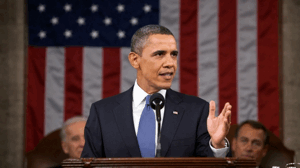
President Obama delivers his State of the Union address (White House Photo: Pete Souza)
CURWOOD: From the Jennifer and Ted Stanley Studios in Somerville Mass, this is Living on Earth. I'm Steve Curwood.
GELLERMAN: And I’m Bruce Gellerman. He never said the words "environment" or "climate." But at the top of his list were investing in the future and clean energy. President Obama made the pitch in his 2011 State of the Union address and he wants to tap some deep pockets to pay for it:
OBAMA: I’m asking Congress to eliminate the billions in taxpayer dollars we currently give to oil companies. (Audience clapping). I don’t know if you’ve noticed, but they’re doing just fine on their own. So instead of subsidizing yesterday’s energy, let’s invest in tomorrow’s.

President Obama delivers his State of the Union address (White House Photo: Pete Souza)
GELLERMAN: The President outlined ambitious goals for the future, and he wants to start right away:
OBAMA: Tonight, I challenge you to join me in setting a new goal: by 2035, 80% of America’s electricity will come from clean energy sources. (Audience clapping). Some folks want wind and solar. Others want nuclear, clean coal, and natural gas. To meet this goal, we will need them all – and I urge Democrats and Republicans to work together to make it happen.
CURWOOD: Joining me in the studio to discuss President Obama’s address is Kevin Knobloch. He’s President of the Union of Concerned Scientists. Mr. Knobloch, welcome.
KNOBLOCH: Hello Steve.
CURWOOD: Also on the line is James Connaughton. He’s Executive Vice President of Corporate Affairs for Constellation Energy and for eight years headed the Council on Environmental Quality for President George W. Bush, hello, Sir.
CONNAUGTON: Hello, good to talk to you again.
CURWOOD: The President’s goal of 80% clean energy by 2035 struck me as, well, a very bold vision for the future of our energy make up. Jim Connaughton, how did it strike you?
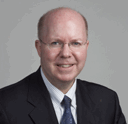
Jim Connaughton is the Vice President of Corporate Affairs and Public Environmental Policy at Constellation Energy. (Constellation Energy ©)
CONNAUGHTON: I liked it and I thought it was hitting some of the themes that should be responsive over time to Republicans. I’d liked it for its ambition, but also because it is reasonably ambitious. I’m at Constellation Energy - our fleet is already at or on its way to meeting the goal today. So we know it can be done. The challenge of the goal is to create a policy environment where it could be done cost effectively.
I also think that’s possible, and that’s where I think the themes matter. Basically, President Obama adopted the all-of-the-above commentary that was really dominant in Republican circles. So, he’s reaching out, he’s sending out common ground signals, you know, can we take the time necessary for folks to find the common ground - that’s the open question. I’m hopeful.
CURWOOD: Kevin Knobloch, what about this all-of-the-above approach? First, what about the vision, and this vision includes things like coal and nuclear that you have questions about.
KNOBLOCH: Steve, I thought it was, it may have been the single most presidential moment in the speech. I mean, this is what Presidents do, they point the prow of the nation into the future, and he planted that flag out there very boldly. He also kind of laid down the gauntlet a bit for the Congress to say, ‘you may be a constituent for carbon capture and storage, for nuclear, natural gas, renewables - you need to be at the table and help us get there.’
It was all-of-the-above, with one very important exception - coal. In terms of burning coal as we traditionally would. Coal is such a harmful fuel. Between respiratory disease, mercury poisoning, mountaintop removal and global warming - soot, smog and so on - it is a very costly fuel. We don’t think of it that way because those costs are not captured, typically, the cost of burning that lump of coal. That said, we rely on coal for 50 percent of our electricity nationally - it’s not going to turn off tomorrow - the cleaner we can get it, the better.
CURWOOD: Jim Connaughton, what about clean coal?
CONNAUGHTON: Coal, today, now, can be very clean from the perspective of cutting the air pollution that people typically associate with ozone, or with acid rain, or the type of air pollution that harms asthmatics. Carbon dioxide, though, those controls actually increase the carbon dioxide emissions because it takes energy to run the pollution control equipment, ironically enough.
And so, I think the idea of a clean electricity standard would be to create the signal that if you can meet this standard - coal, you’re still in! And I think that’s the opportunity the President’s, you know, sort of open-ended invitation created, and I think that’s the right way to do it.
CURWOOD: So, here’s a question, how do you get to 80 percent clean energy in the next 25 years without a cap-and-trade program to price carbon and to send the market signals?
CONNAUGHTON: This is Jim Connaughton. There are actually many different ways to achieve a market-based policy outcome. Cap and trade is one of them. It’s one that I personally prefer, if it’s done right, prior proposals were not very well done. On the other hand, a clean electricity standard is also a market-based approach, incentives are also a market based approaches, as are carbon taxes, or emissions taxes. So, there are many different ways to use a market-based approach that would be consistent even with conservative regulatory philosophy. And so I think the clean electricity standard is a pretty good other way of doing it.
CURWOOD: So, Kevin Knobloch, how do we get to this 80 percent clean energy portfolio without a cap and trade program?
KNOBLOCH: This clean energy program, it’s built on the enormous success of the 30 states that have adopted and implemented state renewable electricity standards. And half of those states have gone back and increased their percentages because they were on such a strong track. There’s a lot of renewables, there’s a lot of clean energy in the pipelines that’s gonna come online in the years ahead.
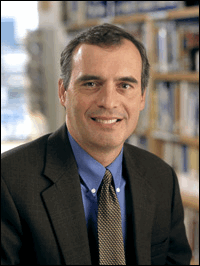
Kevin Knobloch is President of the Union of Concerned Scientists (Union of Concerned Scientists)
So, this builds on that. And our analysis shows that we could actually get to 80 percent, if you continue the current levels of nuclear, current levels of hydropower, and continue to use the evolving efficiency of our homes, our businesses, our vehicles and address a lot of renewables. We think we can get there.
CURWOOD: Constellation Energy is a leading advocate for the development of new nuclear plants in the United States. Is it far to say that, Jim Connaughton, and if it is, how do you do that without more subsidies from the federal government, from taxpayers?
CONNAUGHTON: So, we have been a strong proponent of new nuclear, and we’re one of four companies that are ready to go ahead and build one of these new plants. We ran into a policy brick wall, if you will, having to do with how the Energy Bill of 2005 was implemented when it came to loan guarantees.
And so the sector doesn’t need subsidies in the sense that you need to appropriate tax-payer dollars and just give it to the sector, what the sector actually needs is just a back stop. Because these plants are so big and take so long to build, you know, these plants are about ten billion dollars or more each; none of us is big enough to carry it on our balance sheet. And so we need the government to help provide a guarantee to help get the thing built.
CURWOOD: Kevin Knobloch?
KNOBLOCH: Well certainly the problem of global warming is so overwhelming and proceeding at such an alarming pace, that if the nuclear industry truly could step up and pick up a big share of the greenhouse gas reductions, and do it in a safe and cost effective way, I think you would see a lot of support. You know, the real trick here is that this is a heavily subsidized industry by the American people.
The legacy subsidies, it was basically built on the back of public subsidies, and now the industry is back at the table asking for a new round of subsidies. You know, we have to find a formula here where the nuclear industry can, in fact, as I say, pick up a bigger share of the clean energy load, but in a way that’s sustainable, in a way that is a business plan that Wall Street would actually get excited about and invest in.
CURWOOD: So in the President’s State of the Union address, I didn’t hear the word ‘climate,’ I didn’t hear the word ‘environment.’ Last year he mentioned the climate bill once, and climate change, twice. What’s going on here - Jim Connaughton?
CONNAUGHTON: Well, it’s interesting you ask that, because I pulled up some of President Bush’s State of the Unions, and in his last State of the Union where he called for the big transportation mandates, the fuel economy standards, the renewable fuel standards - he explicitly did mention climate change, and so, people should look to what President Bush put in the State of the Union. I would not be overly critical of President Obama for leaving it out - I hope and believe he was creating an opening, that we had such a fixation on carbon, which, by the way, is important - but we’ve had a fixation on it to the exclusion of other important goals, such as improved air quality and public health, and energy security. It’s just good old-fashioned innovation and competitiveness.
So, I’d like to imagine that he was trying to create an opening to say ‘look, I don’t need to sell you on fully buying into the climate agenda if you’ll join me in buying into the clean air, the energy security and the competitiveness agenda, or any mix of those.’ And, by the way, that’s where the conversation needs to be anyway.
CURWOOD: Kevin Knobloch, we didn’t hear 'climate' or 'environment' this time.
KNOBLOCH: Well, I appreciate the nuance that Jim is drawing, but it was quite disappointing that the President did not talk about climate change. What we’ve seen over the last couple years, as we tried to legislate on this issue was a very cynical attack on climate science and on scientists, coming out of the fossil fuel industry, coming out of the U.S. Chamber of Commerce, the U.S. Petroleum Institute and elsewhere, and I feel it’s important that the President help the American people understand how robust the body of climate science is, what the environmental, human health and security implications are for this country, and economic considerations. And there’s a story to be told there.
CURWOOD: Of course, a big theme of the State of the Union address was the economy. And to cut the deficit, the President suggested that we freeze annual federal spending for the next five years. So how do we achieve the goals that we’ve talked about, the innovation, the expansion of renewable and clean forms of energy, electric cars, all that sort of thing, AND keep federal spending flat? Kevin Knobloch?
KNOBLOCH: There are a lot of resources at the federal level in play, and simply adding the dollars doesn’t always result in full benefit. So by actually freezing domestic spending, it does put pressure on those existing dollars to be more effective, to do more work. And so the President himself said, let's shift oil and gas subsidy money over to our cleaner energy technologies, I think that’s smart, and then the other way to do it is through performance standards, through renewable electricity standards where you - there’s no taxpayer dollars in play, but you’re requiring companies to step it up and in the case of renewable standards, that then is a game plan, a map for investors to come into a space and invest in renewables because they know there will be a market.
CONNAUGHTON: This is Jim. During the Bush administration, the annual spending in terms of incentives and subsidies in the energy, clean energy, space, rose to a level of greater than 40 billion dollars over eight years. President Obama has already doubled down on that, to his credit, I think that was great, and so you’re working with a pretty big pot, so, already, even with the freeze.
So what I would do, and I think a real bold innovation by the President, would be to take all of the existing pot of subsidies and put them altogether, and then redistribute them on a performance basis based on an emissions profile, and then I would add in the energy profile - you know, the higher energy content you get a higher amount of subsidy, and create a good old fashioned competition.
And clearly that, by the way, would move oil to the bottom of the list, but it would lead them in to innovate, if they could find a way to change their profile. So I think that that would be a huge thing and you get much more bang for the same amount of buck - and the bucks are big!
CURWOOD: It’s time now to give the President of the United States a grade for his State of the Union address in connection with the environment and energy. Kevin Knobloch, how would you score him?
KNOBLOCH: I would give him a B+ or an A- with the debit coming from his omission of discussing global warming in a direct way with the American people.
CURWOOD: Jim Connaughton?
CONNAUGHTON: Well, I’m going to reserve my grade and give him an incomplete, because what I want to grade is the actual legislative proposal.
CURWOOD: Kevin Knobloch is president of the Union of Concerned Scientists, and James Connaughton is vice president of executive affairs for Constellation Energy. Thank you both so much.
KNOBLOCH: Thank you, Steve.
CONNAUGHTON: Thank you.
Related links:
- Constellation Energy
- Union of Concerned Scientists
GELLERMAN: Just ahead - big changes for the White House environmental team - keep listening to Living on Earth!
Energy & Climate Czar Leaves White House
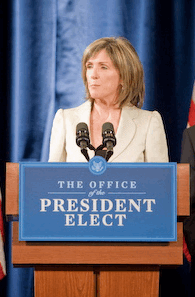
President Obama's "climate czar" Carol Browner's departure is another sign the administration has put efforts to directly reduce greenhouse gas emissions on hold.
CURWOOD: It’s Living on Earth, I’m Steve Curwood.
GELLERMAN: And I'm Bruce Gellerman. The President has thrown his weight behind an ambitious clean energy plan. But in the wake of the failed effort to get a bill through Congress last year to address climate change, a key White House official is stepping down. Carol Browner was appointed to the newly created post of “energy and climate czar” at the outset of the Obama Administration. Now she's out and the future of the position is unclear. Living on Earth’s Mitra Taj has our report from Washington.
TAJ: When Carol Browner joined the White House to help the president broker a cap-and-trade deal in Congress, hopes for tough action on climate change were high. After all, Browner had served as Bill Clinton’s EPA administrator for two terms, and was a tireless advocate for keeping the planet cool. Here she is in 2006 as a private consultant commenting on George W. Bush’s lack of a climate plan:
BROWNER: This has been a passion of mine for many years. I think the single most important thing we can do now is call on Congress to set a cap, a national cap on greenhouse gas emissions. And I'm disappointed this administration has not taken the lead.
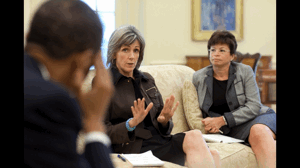
Browner briefing President Obama on the BP oil spill, one of her White House responsibilities when not working with Congress on a climate bill. (Photo: Pete Souza, The White House)
TAJ: Browner ended up on the other end of that disappointment last year when she stood solemnly next to Senate majority leader Harry Reid to deliver the news that the fight for climate legislation was ending. There simply weren’t enough votes.
BROWNER: Now obviously everyone is disappointed that we do not yet have an agreement on comprehensive legislation…
TAJ: Her departure is another reminder that tackling climate change is politically tough, and that the President has other priorities. Eric Pooley is the deputy editor of Bloomberg Businessweek and the author of the book “The Climate War.”
POOLEY: Despite all of Carol’s hard work the administration itself never threw its weight behind a specific bill. And so yeah, is it another milestone along a long road? I’d say yeah, it is. I think it’s a kind of a mop-up action in the same way that Joe Lieberman leaving the Senate is a sign that an era has passed, and there was an opportunity to make progress in that era in my view and we squandered that opportunity.
TAJ: Browner didn’t get a climate bill but she was key in negotiating new emissions standards with automakers. And where some like Pooley see a loss, some in Congress see victory.
ISSA: There is no vacuum left by her departure.
TAJ: California Republican Congressmen Darrell
Issa is chair of the House Oversight and Government Reform Committee. He planned to use his authority to investigate Browner’s involvement in the administration’s environmental decision-making, and block her authority as a “czar.”
ISSA: What we want to do as a committee is we want to end unconfirmed czars. We want to ensure that people who control the taxpayer dollars or the authority of the president do so through a process of being named and confirmed by the Senate.
TAJ: The White House hasn’t said whether someone might take Browner’s place, and now that she’s leaving, Issa says he wants to help Congress keep the EPA from regulating greenhouse gas emissions. Using EPA’s authority was the administration’s backup plan in the absence of a climate bill. Eric Pooley says Browner might have been useful in blocking attacks against the agency.
POOLEY: That’s going to be a big battle, but it’s a defensive battle and she chose not to stay around for that particular fight.
TAJ: While Browner prepares her exit, the spotlight is now on another star of the President’s “green team”, Department of Energy Secretary Steven Chu, to move the administration’s clean energy goals forward. The President’s State of the Union speech was sprinkled with references to efforts Chu will lead, and the thrust of the speech itself…
OBAMA: Half a century ago, when the Soviets beat us into space with the launch of a satellite called Sputnik…
TAJ: …had already been voiced by secretary Chu last fall:
CHU: On October 4th, 1957, Soviet Union launched a satellite, Sputnik.
TAJ: Chu’s “Sputnik moment” speech, like the president’s, also emphasized the need to invest in science and clean technology to get ahead in the world. And now it’s up to members of Congress to determine whether they think it’s the right moment. For Living on Earth, I’m Mitra Taj in Washington.
Related link:
Click here to watch Secretary Chu's 2010 Sputnik speech
CURWOOD: Coming up -- a massive lawsuit to protect endangered species could change farming as we know it -- but first this note on emerging science from Jessica Ilyse Smith.
Science Note/Salt-Sized Batteries
[SCIENCE NOTE THEME]
SMITH: Researchers at the University of California, Los Angeles are thinking big by building small. They’re developing nano-batteries, the largest of which will be no bigger than a grain of salt.
They will be tiny compared with the traditional ion batteries powering today’s laptops and smart phones, but they’ll pack the same punch. To make them, researchers carefully spray the surfaces of nano-wires with conductive material, which enable the flow of energy between electrodes.
Scientists hope their work will create batteries to power electronic gadgets of the future. Shrinking the batteries will lighten the load of electronic devices, making them easier to carry. Their light weight is one reason why the military is funding this study.
Researchers expect to have a complete prototype in three years, but consumers will have to wait a bit longer before high-tech devices with nano-batteries are available commercially. At any rate, you can say UCLA scientists are leading the charge. That’s this week’s note on emerging science, I’m Jessica Ilyse Smith.
The Search for Neutrinos in the Antarctic
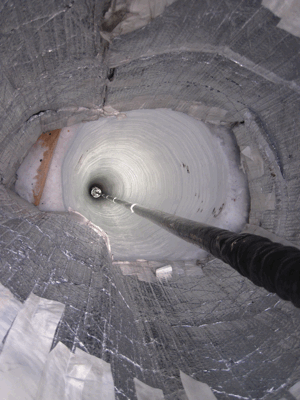
A sensor descends down a hole in the ice as part of the final season of IceCube. (NSF/B. Gudbjartsson)
CURWOOD: In the IEEE Spectrum's documentary Antarctica: Life on the Ice, scientists search for neutrinos. These tiny, tiny, sub-atomic particles streak across the universe -- they're among the most common things that exist — yet also among the most difficult to detect. In a unique effort to see neutrinos, engineers are now turning a cubic kilometer of ice under the South Pole into one of the oddest telescopes in the world.
By spotting some of the countless neutrinos that pass through matter, this telescope is expected to help scientists understand cosmic mysteries such as black holes, exploding stars, and dark matter. Glenn Zorpette visited Antarctica and took a look.

A sensor descends down a hole in the ice as part of the final season of IceCube. (NSF/B. Gudbjartsson)
[PUMP-ROOM SOUND]
ZORPETTE: How do you make a hole two and a half kilometers down into solid ice? You melt your way down. It takes two days and 20 000 gallons of hot water. Dennis Duling showed me how it’s done.
DULING: That’s our drill water for this project.
ZORPETTE: So you actually use hot water to drill?
DULING: Yes we do.
ZORPETTE: There’s no metal bit. Just hot water.
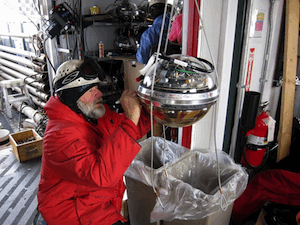
Drilling manager Dennis Duling. (NSF/J. Haugen)
DULING: We use 200 gallons a minute at 90 C, which is boiling in the environment. And we push it out at 1,000 pounds of pressure out of a three-quarter-inch nozzle. That equates up to the power of a Burlington locomotive, a big one at full power, coming out of that nozzle. That’s why this drill will drill what it drills.
[PUMP-ROOM SOUND]
ZORPETTE: Duling is the drill manager for the company building the IceCube observatory. So far, he’s drilled 79 of these mile-and-a-half holes in a kilometer-square stretch of ice near the South Pole. He has seven more to go.
[MACHINERY RUNNING]
ZORPETTE: Once a hole is drilled, technicians lower into it a string of 60 basketball-sized light detectors. By February of 2011, over 5,000 detectors will lie frozen in a billion tons of ice. They’re going to look for the most elusive particles in the universe: neutrinos.
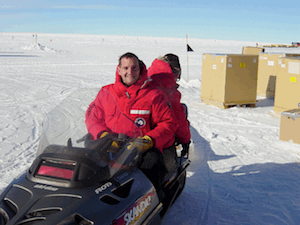
Physicist Mark Krasberg (NSF/Hagar Landsman)
KRASBERG: Neutrinos are really neat—they’re chargeless, they’re almost massless. You’ve actually got 10 million going through your thumb every second. They’re really, really hard to detect.
ZORPETTE: Mark Krasberg is a physicist on the
IceCube project. He explains that because neutrinos don’t interact with anything, they’re very hard to detect. But that same lack of interaction also means they can zip across vast stretches of the universe unimpeded. So to astronomers, neutrinos are like minuscule messengers carrying news about exploding stars, baby black holes, and other violent events that occurred unimaginably far away, and an unimaginably long time ago.
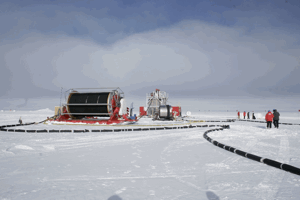
The drill shack for the Ice Cube project is the square near the center of the image. The hose carries superheated and super-pressurized water that drills holes one and a half miles deep in the ice, near the South Pole. Light detectors placed in the holes will sense very faint, blue Cherenkov radiation, given off by muons, created by neutrinos moving through the ice. (Photo: Glenn Zorpette)
KRASBERG: Since neutrinos are chargeless, they go on a straight line through the universe. You basically, if you have a source, just have a straight line going back, and you can ask an astronomer, "what’s at that spot in the sky"?
ZORPETTE: Neutrinos can also come from sources closer to home. In fact, neutrinos coming from the center of our Sun or our Milky Way galaxy could give physicists clues about the nature of dark matter, the mystery mass that pervades our universe but about which nothing is known. But how do you detect particles that are almost undetectable? Well, the IceCube telescope is looking for the one-in-a-million neutrino that crashes into an atom of an ice molecule and creates another particle called a muon. As that muon shoots through the ice, it gives off blue light. In the pure, incredibly clear ice of the South Pole, that tiny bit of light can travel hundreds of feet. And then it can hit those basketball-size light detectors.
KRASBERG: It’s basically an inverse lightbulb. It collects the light and converts it into charge. There’s a computer on top of here and the signals go to the surface.
ZORPETTE: Researchers hope these ghostly particles will help them solve some of the biggest mysteries of the universe. And, if they do, then one day this strange telescope under the ice might not seem so strange after all.
CURWOOD: Our story, by IEEE Spectrum's Glenn Zorpette, is from the documentary Antarctica: Life on the Ice.
Related links:
- Ice Cube Project
- IEEE Spectrum’s Antarctica: Life on Ice Documentary
Environmental Groups vs. EPA
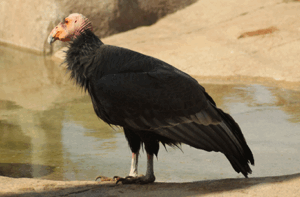
Creatures like the California Condor are critically endangered, and this lawsuit states that some pesticides might harm such animals. (Wikimedia Creative Commons)
GELLERMAN: Two environmental organizations have launched a federal lawsuit designed to protect over two hundred endangered species from commonly used pesticides. But if the suit is successful it could have a profound effect on the nation’s farmers and you. The Center for Biologicial Diversity and Pesticide Action Network charge that the U.S. EPA has violated the Endangered Species Act.
The groups allege the EPA was required to consult with other federal agencies regarding the impacts of pesticides on threatened species - but never did. West Palm Beach attorney Keith Rizzardi has been following the federal suit - he writes a blog about the Endangered Species Act. Mr. Rizzardi welcome to Living on Earth!
RIZZARDI: Thank for having me.
GELLERMAN: Now, we should say that you’re not part of this lawsuit.
RIZZARDI: Not at all.
GELLERMAN: This thing is, what, 400 pages long and the EPA basically is charged with failing to follow the federal rules.
RIZZARDI: Yes, it’s a very significant law suit. And if it were to go to the merits, it would have significant consequences for how pesticides are administered in the nation.
GELLERMAN: In this lawsuit what they’re charging is that there are 300 pesticides that violated the Endangered Species Act.
RIZZARDI: Yeah, three to four hundred different pesticides are identified, over 200 different species are identified, you know, if you do the permutations, you could be talking about 80,000 combinations. And by my best guess, this lawsuit suggests that about 27,000 different analyses are needed.
GELELRMAN: Well, the EPA knows its own rules - how could they have not followed them for this long?
RIZZARDI: I don’t think the question here is how could EPA have not complied with the law. They did comply with all their responsibilities under the federal Insecticide, Fungicide and Rodenticide Act. And in fact, this lawsuit says, it’s not about IFRA, it’s about the Endangered Species Act. The concern being raised in the complaint is that the Center for Biological Diversity simply believes is what EPA is already doing is not enough.

Creatures like the California Condor are critically endangered, and this lawsuit states that some pesticides might harm such animals. (Wikimedia Creative Commons)
GELLERMAN: And that layer of analysis is that they should have gone to other federal agencies and asked them how it is affecting endangered species?
RIZZARDI: Yes, and as President Obama joked in his State of the Union Address, it could be both the National Marine Fisheries Service and the US Fish and Wildlife Service depending on which species you may be talking about.
GELLERMAN: I understand that this is not the first time that the EPA has been sued on this issue, and sued successfully.
RIZZARDI: That’s true, there have been other lawsuits brought by the Center for Biological Diversity involving pesticides and other species. It happened with the California gnat catcher, it also happened with Pacific Northwest salmonid species.
GELLERMAN: And the environmental groups won.
RIZZARDI: Or a settlement was achieved, yes sir.
GELLERMAN: Given that the EPA has settled in past cases regarding this, how come they have to face yet another lawsuit?
RIZZARDI: Well, one thing that’s important to keep in mind is that the Environmental Protection Agency is not the ultimate authority on threatened and endangered species. The consulting agencies are the US Fish and Wildlife Service and the National Marine Fisheries Service. And those are the agencies whose roles are at issue. And the question is raised in this lawsuit is whether EPA had a duty and should have gone back and talked to those agencies about the consequences of the pesticides for these given species.
GELLERMAN: Um, my sense is that this lawsuit could have extraordinary broad implications. I was reading, you know, something that the executive director of the Kansas Corngrowers Association said that - and he said - this is more of an assault on modern agriculture than it is about protection of endangered species.
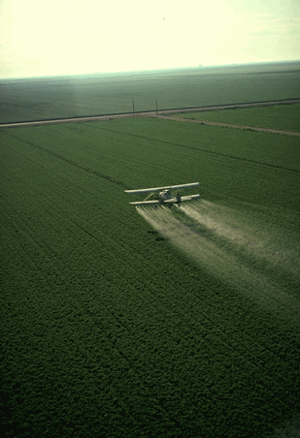
A cropduster plane spraying a field with pesticides. (Wikimedia Creative Commons)
RIZZARDI: It’s true that this lawsuit could have very significant nation-wide consequences. And could indeed lead to a significant re-write of the way that many of our pesticides are used. One of the things to understand about the Endangered Species Act is that it was meant to be the Noah’s Ark of environmental law. It was supposed to be a last resort and a way, when it was originally created, for federal agencies to take a real careful look at their proposed actions. And evaluate them with respect to individual species before they took them. And one thing about the law here is that it adopts the precautionary principle.
It says in all cases do no harm to the species, and in some cases it talks about erring in favor of the species when you have concerns. But what you’re seeing here is the continued evolution of the Endangered Species Act and the use of the Endangered Species Act sort of as a policy proxy and a surrogate for other things. And in this case it could possible function as something of a surrogate for FIFRA reform- the Federal Insecticide Fungicide and Rodentide Act.
By way of example, let me take you back to the lawsuit in the Pacific Northwest. The biological opinion that ultimately got issue found that some of the pesticides were likely to jeopardize the continued existence of some of the salmon species. As a result, the National Marine Fisheries Service imposed some additional conditions on how those pesticides could be used, such as wind speed restrictions - when the wind is blowing higher than a certain rate, you shouldn’t be applying the pesticides.
They put restrictions on moisture - they said that when it’s really wet, it’s likely that that pesticide will have an easier time of getting into the watershed, so you can’t use it then. They created fish mortality reporting requirements, and they created habitat monitoring reporting requirements - all of that grew out of the Endangered Species Act, and were additional requirements that went above and beyond what was previously being required under the FIFRA terms.
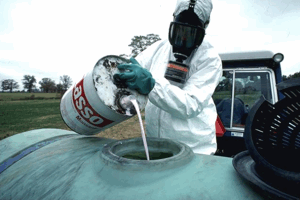
Preparing for pesticide spraying. (Wikimedia Creative Commons)
GELLERMAN: So, take a lawyerly position. If you were a government attorney trying to defend against this lawsuit, what would be your response.
RIZZARDI: Every case is very fact-specific, and requires you to take a very good look at the record. And the record is an administrative record, it’s the whole history of what the federal government has done on a given issue. And barring having that set of documents in front of me, I’m not sure what position I’d take right now, but I can say looking at it, yeah, I’d be nervous!
GELLERMAN: Well, Mr. Rizzardi, thank you very much, I really appreciate it.
RIZZARDI: Bruce, it was really wonderful talking with you.
Related links:
- Visit Keith Rizzardi’s Endangered Species Act blog
- Visit the Center for Biological Diversity’s website
- View the press release for this landmark case
GELLERMAN: Keith Rizzardi is an attorney in West Palm Beach, Florida. His blog is called the ESA Blawg. B-L-A-W-G.
[OPENING MAIL THEME]
Listener Letters
CURWOOD: It’s time now to open our mail.
GELLERMAN: Lots of listeners applauded our conversation with scientist David Suzuki - calling our interview about his vision of the world and our future - “stunning – powerful – galvanizing – and sobering”. Jim Francis wrote on our Facebook page - “Finally, a voice of sanity to remind us that we are overpopulated and getting more so.”
CURWOOD: David Suzuki’s comparison of human demands on the Earth to the exponential growth of bacteria in a test-tube brought back memories for Steven Underwood of Ormond Beach, Florida.
UNDERWOOD: As I tried to educate my high school biology students for over 32years, it is not that our planet does not have enough resources, we have too many people. Until we decrease this population we will continue to use up our finite resources. We have the choice to control this population before nature does. I don’t think that mankind would like Nature’s methods of controlling the human population
GELLERMAN: Many of our listeners found our investigative report on the endocrine disrupting effects of pesticides on sex organs and sexual orientation "disturbing" and "fascinating".
Connie Dodson wrote, " If atrazine has the effects you reported on frogs, and, frogs, rats and humans have the same sex hormones, this is a real problem: too many male baby frogs is one thing, but too many feminized men is a problem….."
Some listeners asked what about these chemicals' effects on female sexual development?
CURWOOD: Good question - and, well, so far there's not much science in this area. But as gynecologist Debra Ravasia wrote from Spokane Washington, "Women have symptoms of high levels of estrogen exposure, too – in this case she cited that breast cancer has increased 30% in the last 30 years, the age of onset of menses is younger in the USA than in other countries, and she notes that the obesity epidemic has correlated with the rise of the hormone disrupters in our food chain…
GELLERMAN: Well, love us or hate us - we always try to give you food for thought - and we're glad to hear from you. Our address is: comments @ L-O-E dot org. – comments@loe.org - or call our listener line – 1-800-218 –9988 – 1-800 - 218 - 99-88 or click on over to our facebook page – it’s P-R-I’s Living on Earth.
GELLERMAN: Just ahead – an International film festival where forests come in first. Stay tuned to Living on Earth!
Huge Methane Emissions from Fresh Water
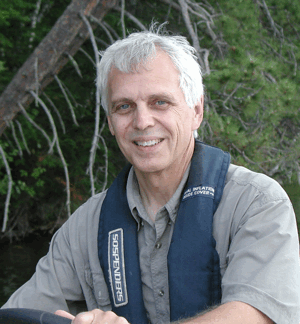
Professor John Downing still loves lakes. (Courtesy of John Downing)
CURWOOD: It’s Living on Earth, I’m Steve Curwood.
GELLERMAN: And I'm Bruce Gellerman. Here’s something that might surprise you - it certainly surprised scientists. The world’s freshwater lakes, streams, ponds and swimming holes store and release immense amounts of climate changing greenhouse gases, especially methane, which is one of the most potent. Scientists found a lot more of it than they expected and their discovery is in the latest edition of Science magazine. John Downing is one of the co-authors of the article. He’s a limnologist at Iowa State University in Ames - and Professor, welcome to Living on Earth!
DOWNING: Well thank you very much it’s a pleasure to talk about this.
GELLERMAN: So, what’s a limnologist?
DOWNING: Well, a limnologist is a scientist that studies inland waters, or continental waters - lakes, ponds, rivers and streams.
GELLERMAN: Well, for this study for Science, you studied a lot of them!
DOWNING: Yeah, I think it was 400, yeah 474 I think is the number we finally ended up with. A large number of systems across the world, but there are millions of lakes and ponds, and those are hopefully representative of them.
GELLERMAN: So what did you find? You were looking for what specifically?
DOWNING: So we were trying to see how much methane, a really important greenhouse gas, might be emitted by inland waters because it hadn’t been included in really any global budget.
GELLERMAN: So where does the methane in freshwater bodies come from?
DOWNING: Well basically decomposition of organic matter that flows into them, or organic matter that’s created within them.
GELLERMAN: So you found that freshwater bodies of water have a lot of methane stored in them and that they’re releasing a lot of it. How much are we talking about here?
DOWNING: Well, it’s kind of hard to wrap your head around the numbers, because they’re usually measured in things like petagrams which is an enormously immense amount of material. But it’s equivalent to about 25 percent of all of the carbon that’s taken up and sequestered by terrestrial environments worldwide.
GELLERMAN: And terrestrial environments is the land environments, of which these ponds and lakes are part of.
DOWNING: Right. Global ecologists have sort of divided the world into three big chunks, and one of them is the ocean, another is the continents and the other is the atmosphere. What we’ve been finding over the last four years or so is that when we consider the lakes - the wet part, the aquatic part of the continental mass, they are so much more active than any piece of real-estate on the planet.
GELLERMAN: So Professor, how much of the world’s surface is freshwater?
DOWNING: It looks to be about 2.8 to three percent right now. But five years ago, the estimate was about 1.5 percent of the land surface made up of lakes and ponds.
GELLERMAN: So how is it that we didn’t know where, I guess, half the world’s fresh water was? Before not too long ago?

Professor John Downing still loves lakes. (Courtesy of John Downing)
DOWNING: A group of scientists and I, working at the National Center for Ecological Analysis and Synthesis, put together a lot of very exacting analyses of aerial and satellite photos, and began to find that there were many more small systems - small lakes and ponds than anyone had suspected.
GELLERMAN: So, to quote former president Bush, you’ve ‘mis-underestimated’ these lakes!
DOWNING: Well, I didn’t. I was pretty convinced that it would be there as was David Batsviken and Lars Tranvik and the other scientists who worked on this project. So what we’ve failed to do, really, was to consider a piece of that global budget.
GELLERMAN: When you’re talking about a global carbon budget, you’re talking about the amount of carbon that’s stored and released.
DOWNING: That’s right. And, it’s really important to know what all the major sources and sinks of carbon are. It’s sort of equivalent to running your own household budget, calculating all of your sources of incomes and expenses, and forgetting that the insurance company takes an amount out of your account each month that’s equal to 25 percent of your household income - kind of a big mistake, even a limnologist would know enough economics to make that work better!
GELLERMAN: So what happens now with this information? Does it help us, or does it hurt us?
DOWNING: Well, I think it points up a few things. It makes me feel as if we really need to pay more attention to these inland waters and what they are doing, because they are so active in everything they do that the fact that they may be only 3 percent of the land area of the planet is less important then their great activity.
So, paying attention to inland waters is very important. And then I’d say if we made this kind of an error here, what other pieces of this puzzle are missing - what other pieces might we need to fill in - and we should be paying attention to environments that are highly carbon active, even though they may be small.
GELLERMAN: So, good and bad things come from small packages.
DOWNING: Yeah, that’s in fact true. They are small, but they’re mighty. The little farm-ponds of the world probably bury or sequester as much carbon every year as the world’s oceans, and the lakes and sort of moderately sized water bodies of the earth, sequester four times the carbon that’s buried by the oceans in a year. So we have to look for not just big and obvious sources and sinks of carbon, but look at those that may be small and highly active.
GELLERMAN: Professor Downing, I was looking at your webpage, and you quote Thoreau.
DOWNING: Uh, yeah, I’ve got it right in front of me - it’s one of my favorites, it goes: “A lake is the landscape’s most beautiful and expressive feature. It is earth’s eye, looking into which the beholder measures the depth of his own nature.” Thoreau is a hero of mine, and of course, most ecologists.
GELLERMAN: It’s Earth’s eye, but I’m wondering now with your research, if it’s Earth’s black eye?
DOWNING: Not at all! We shouldn’t ever consider that lakes are bad. The rates that were measured by Batsviken and his crew of scientists from around the world - these rates of methane emission are natural and have been there a long time. Maybe if we have a black eye, it’s because we haven’t paid attention to some of earth’s most carbon-
active environments and we need to be doing that.
GELLERMAN: Well, professor Downing, it was a real pleasure, I really appreciate it.
DOWNING: Oh, what a pleasure it is for me to talk about this work. Thanks for asking me.
Related links:
- Read the abstract of “Freshwater Methane Emissions Offset the Continental Carbon Sink” in January’s Science magazine. Subscription required for full text
- In “Lakes (Formation, Diversity, Distribution),” Downing and his colleague accounted for twice as much freshwater than had previously been estimated.
- Learn more about importance of global limnology in John Downing’s treatise on the topic.
Forest Films

The International Year of Forests will be launched at the UN General Assembly in February.
CURWOOD: It’s that time of year when Hollywood puts on the glitz and glamour - Academy Award Season. But forget the Oscars - in New York City, they’re rolling out the green carpet for the first International Forest Film Festival. The festival kicks off the United Nations International Year of the Forest. It's a series of events designed to raise global awareness about the forests of the planet. Over 160 films were submitted in six categories, and here with the envelopes is Jan McAlpine. She's one of the three judges, and director of the UN Forum on Forests. Ms. McAlpine, welcome to LOE.
McALPINE: Thank you, I’m delighted to be here.
CURWOOD: So let's first talk about the UN International Year of the Forest - what will you be doing to raise awareness?
McALPINE: We have a global launch, which will take place on the 2nd of February in New York at UN Headquarters with some very eminent people, and interspersed with those speakers will be film clips from the International Forest Film Festival.
CURWOOD: Now, why have a film festival? And, by the way - what’s the name of an award for your film festival?
McALPINE: Well, you know, we’re welcome to accept ideas for the name of the award.
CURWOOD: Well, um, maybe you should call them the ‘woodies’!
McALPINE: (Laughs!) Uh, no. I don’t think so. Maybe, I don’t know, the green award. We’ll have to come up with something good, won’t we?
CURWOOD: Well, it’s a tree, you’re going to have to call it the ‘big green!’
McALPINE: Yeah, the big-green, I like it! Okay, you can be part of our brainstorming team.
CURWOOD: Now, there’s one film in recognition of the inspiration of an impact that an individual can make on the world, that won a special jury award from you, it’s called ‘The Man who Stopped the Desert’- tell me about this film.
McALPINE: It’s just an amazing film about a man in Burkina Faso. He was somewhat successful in working in the marketplace, had a business, but he decided that he wanted to go back and farm. And when he did, he looked at indigenous farming methods, and he figured out how to use those methods to improve the soil, but he also planted trees in order to create a break for the wind, because that area is very much dry lands, and was fast desertifying. And he actually has a huge impact throughout the region, and now, I think, throughout the world.
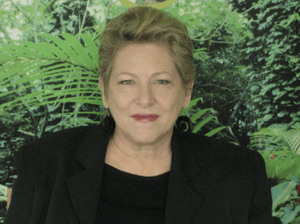
Jan McAlpine (Daphnis Novoa/United Nations Forum on Forests Secretariat)
[CLIP FROM MOVIE: Thanks to his work, vast moonscapes of desert land have been transformed into fertile, life-giving soil…. Crops have been planted… Forests have regrown… And, the people have returned.]
CURWOOD: That’s a remarkable story of perseverance and adversity. That’s a very compelling film, but why did you chose it - why did you select it to be an award winner?
McALPINE: Well, I work for the United Nations Forum on Forest, and one of the things that the forum insisted was that we have to look at trees outside of forests as being as important as large expanses of forests. And what was most impressive here was recognizing the role that trees have even in dry lands. Also, the year of the forest is celebrating forests and people. And this is a great example of the contribution by one person who made a significant difference.
CURWOOD: You had a category of living forests, and the winner of that was ‘Kingdom of the Forest’- here’s a clip from that now.
[FILM CLIP: Seduction. Drama. Danger. And deceit unfold….in the kingdom of the forest.]
McALPINE: This film, as you heard, is just amazing. It really shows how important each creature is and how much each creature depends on the other. It’s a beautifully filmed movie, it also has a terrific storyline and it explains the importance of forests and ecosystems that you can’t capture in words, and my words are a really poor equivalent for this kind of story.
CURWOOD: Now, the winner in the shorts category was ‘Nom, Tèw: Man of the Soil’- now, there’s no narration, but here’s a bit of the soundtrack:
[SOUNDTRACK TO FILM]
McALPINE: It’s a wonderful movie. First of all, I really enjoyed watching a film with no voiceover. When judging the film, a lot of the films we saw - people were talking too much, and the story was often much more told through the visual - visual story. In this case, they didn’t. They showed this man who basically lives in the forest, and he is going and picking fruit and making soup or stew - and it’s just this beautiful…almost like a dance… about his interaction and his knowledge of his own backyard - it’s really beautifully done.

The International Year of Forests will be launched at the UN General Assembly in February.
CURWOOD: You know, I liked one of the finalists in the short category that didn’t make it to winner, this is the one produced by Greenpeace - it starts with a family - they’re sitting in their living room, they’re watching a nature documentary on TV about sharks -
[FILM CLIP: The white shark has a body language of its own which we’re only beginning to recognize…this inquisitive shark uses its…..]
CURWOOD: All of a sudden, bulldozers roll up, chainsaws start roaring, the family’s living room is smashed to smithereens.
[FILM CLIP: SOUND OF CHAIN SAW]
CURWOOD: Not exactly your typical film festival fare.
McALPINE: No, but we had a huge range of films and some of them were, like that one, really great.
[FILM CLIP: Scary, isn’t it? Having your home destroyed around you. But your home can be rebuilt - ours has taken thousands of years to grow.]
McALPINE: It was very hard to pick the finalists. The judges had a terrible time, because a lot of these films should have won - that’s a great example of a terrific story and very vivid storytelling.
CURWOOD: And, you can tell me - are your eyes a little tired after 160 films?
McALPINE: (Laughs.) Yeah, my whole holidays were spent, night and day watching them - but it was fun!
CURWOOD: Thank you, Jan McAlpine.
McALPINE: Thank you.
CURWOOD: Jan McAlpine is the director of the UN Forum on Forests - and a judge of the International Forest Film Festival which was sponsored by the Jackson Hole Wildlife Film Festival. To learn more about the award winning films and a link to see some of them, check out our website at LOE.org.
[ACADEMY AWARD MUSIC]
Related links:
- Learn more about the International Year of Forests
- Watch clips from the winning films, and host your own Forest Film Festival!
[MUSIC, OSCAR THEME]
Elephant Seals in Combat

The female elephant seal threatens. (Photo: Salt Marsh Diary ©)
[OCEAN SOUNDS, ELEPHANT SEAL NOISES]
CURWOOD: And, now we travel from forests….to seas:
[ELEPHANT SEAL NOISES]
CURWOOD: Elephant Seals spend at least two thirds of the year far out to sea. They only appear on shore to breed, seeming clumsy and out of place but elephant seals are at least as formidable on land as in water. Writer Mark Seth Lender saw the seals on the California Channel Island of San Miguel.
LENDER: Blumbering down the strand the Elephant Seal comes, eyes wide and his head in the air. Females beneath his care and command are his wealth. He will defend, and defy all who try to take them from him by the thunder of his voice, by threat of harm, by his will and his three long tons.
The Elephant Seal. A creature like no other. Even his name is a misnomer: no flappable ears, no ears we can see at all. No trunk; what grows pendulous in the middle of his huge face is more like a fighter’s bulbous nose. Nor does he sport tusks. But the folds of his skin say pachyderm and hereabouts, surely he is the biggest.
Four long months, without nourishment of any kind, Elephant Seal lies on the beach and sleeps while the cove about him roils with life and sound: Snorts and coughs and blowing noses of the pups; Coarse growls of mates; A newborn begging for the teat screaming like a broken piccolo. Elephant seal ignores them all. Only to the occasion will he rise….
Having done with nursing and mothering, quietly, while her pup sleeps, one of Elephant Seal’s females begins her escape toward the sea. A Young Bull, smooth of skin and dark and sure sees his chance and comes to pursue what the old bull claims for his own. Eyes wide as an elephant in musth, Elephant Seal wakes with a roar. Chest proud, he charges the foe, sounding his Song of War. In close, all tooth and gaping maw they tear and slash and puncture, red trails of spittle and foam, the slap of bulk on bulk, mass against bone…
Dusk. The female lies with Young Bull, there in a leeward shallow sheltered by a great stone rising like a new throne. Elephant Seal, gouged and gray, lies exhausted, part of his regal nose torn away.
Dawn. The cove is quiet. Even the air is still. Elephant Seal wakes in all his cranky majesty, Beachmaster only in name. He will leave now for the far offshore and never reappear. Not here. Not anywhere. He glomps and flumps his laborious way to the sea. Thuh-bla blu blomp… blomp… And gathers what greatness remains. And goes forward. And goes on.
Behind him, he leaves his mark, a wake made of sand that will last only till the tide comes in, and wipes it away.
[ELEPHANT SEAL NOISES]
CURWOOD: Salt Marsh Diary, a collection of Mark Seth Lender’s writings on wildlife, will be published this coming March by St. Martin’s Press. To see photos of the elephant seals, go to our website, LOE.org.
And before we go - here are some more of Mark’s recordings from the elephant seal colony on San Miguel Island – females and pups call out while bulls clap their flippers to fend off other males.
[ELEPHANT SEAL NOISES]
Related links:
- To see a short film by Mark Lender of the elephant seal combat scene, go to our Facebook page, PRI’s Living on Earth.
- Salt Marsh Diary
- Learn more about the Channel Islands
- Back Story: Listen to a short interview with Mark Seth Lender about his trip to San Miquel Island to see Elephant Seals.
GELLERMAN: Living on Earth is produced by the World Media Foundation. Our crew includes Bobby Bascomb, Eileen Bolinsky, Ingrid Lobet, Helen Palmer, Jessica Ilyse Smith, Ike Sriskandarajah, Mitra Taj, and Jeff Young, with help from Sarah Calkins, Sammy Sousa and Nora Doyle-Burr. Our intern is Wynn Tucker. Jeff turton is our technical director. Alison Lirish Dean composed our themes.
CURWOOD: And you can find us anytime at LOE.org – and while you’re online, check out our sister program, planet harmony. Planet Harmony welcomes all and pays special attention to stories affecting communities of color. Log on and join the discussion at my planet harmony dot com.
And don’t forget to check out the LOE Facebook page, it’s PRI’s Living on Earth. I’m Steve Curwood.
GELLERMAN: And I'm Bruce Gellerman.
CURWOOD: Thanks for listening!
ANNOUNCER: Funding for Living On Earth comes from the National Science
Foundation supporting coverage of emerging science. And Stonyfield farm, organic
yogurt and smoothies. Stonyfield pays its farmers not to use artificial growth hormones
on their cows. Details at Stonyfield dot com. Support also comes from you, our listeners.
The Ford Foundation, The Town Creek Foundation, The Oak Foundation—supporting
coverage of climate change and marine issues. The Bill and Melinda Gates foundation,
dedicated to the idea that all people deserve the chance at a healthy and productive life.
Information at Gates foundation dot org. And Pax World Mutual Funds, integrating
environmental, social, and governance factors into investment analysis and decision
making. On the web at Pax world dot com. Pax World for tomorrow.
ANNOUNCER 2: PRI – Public Radio International
Living on Earth wants to hear from you!
Living on Earth
62 Calef Highway, Suite 212
Lee, NH 03861
Telephone: 617-287-4121
E-mail: comments@loe.org
Newsletter [Click here]
Donate to Living on Earth!
Living on Earth is an independent media program and relies entirely on contributions from listeners and institutions supporting public service. Please donate now to preserve an independent environmental voice.
NewsletterLiving on Earth offers a weekly delivery of the show's rundown to your mailbox. Sign up for our newsletter today!
 Sailors For The Sea: Be the change you want to sea.
Sailors For The Sea: Be the change you want to sea.
 The Grantham Foundation for the Protection of the Environment: Committed to protecting and improving the health of the global environment.
The Grantham Foundation for the Protection of the Environment: Committed to protecting and improving the health of the global environment.
 Contribute to Living on Earth and receive, as our gift to you, an archival print of one of Mark Seth Lender's extraordinary wildlife photographs. Follow the link to see Mark's current collection of photographs.
Contribute to Living on Earth and receive, as our gift to you, an archival print of one of Mark Seth Lender's extraordinary wildlife photographs. Follow the link to see Mark's current collection of photographs.
 Buy a signed copy of Mark Seth Lender's book Smeagull the Seagull & support Living on Earth
Buy a signed copy of Mark Seth Lender's book Smeagull the Seagull & support Living on Earth

